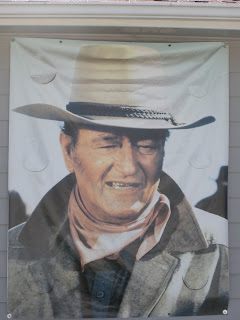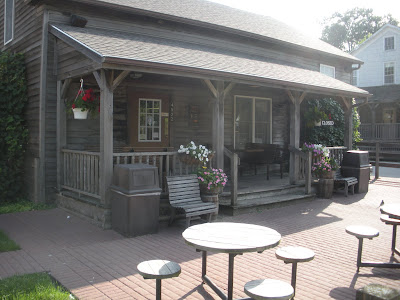
So what's it like traveling and living in an RV? It may come as no surprise to learn that we love it. Tracey and I have found that this size RV - 27 feet - works very well for two people. Not exactly big enough to live in on a permanent basis, but certainly just fine for extended journeys. And it's a veritable palace for one person on the road as I'm doing on this trip
There is a little learning curve when it comes to driving a vehicle this size. But after a day or so, it's not that much different from driving a car or minivan. You do have to be aware of your size and you are much more dependent on your mirrors to keep track of everything around and behind you.
It's really a lot of fun to live in a little cabin that you are driving around. You can cook, eat, sleep, read, watch TV (I haven't had mine on since I left), or anything else you'd do in a house. It's just done in a smaller space. On the other hand, you don't have everything you own with you. Just the things you need and no more. Makes for a much more simplified life. Clean-up is done in a matter of minutes.
Here's the layout of our RV:

This particular RV has two small rooms. There is the kitchen which also includes the dining booth. The kitchen is small, but has everything you need including 3-burner stove, double sink, refrigerator, and microwave.

As for cooking, I make pretty much anything I make at home. My repertoire of recipes is not that extensive anyway. But I have all the ingredients in either the refrigerator or the overhead cabinets or the small pantry. Pots and pans are tucked away under the sink and the dishes are in their own overhead cabinet.




On the way to the back room, you pass through a small hallway. On the right is the bathroom and on the left is a sizable closet which has four drawers underneath like a built-in chest of drawers. It's nice to have, say, your socks neatly in a drawer instead of in a suitcase.



In the back is the "lounge." This room has two comfortable sofas that face each other. They can fold out and slide together to make a larger-than-king-size bed. There is a panoramic view out the back provided by three large windows on the right, left, and rear. Overhead are large compartments for clothes or other items.

Life on the road is made much more comfortable by all the technological gadgets we have these days. I couldn't make a trip like this without access to the internet. I research the places I want to visit, use email, and work on this blog using my laptop and a Verizon aircard. This small device fits in a USB port on the computer and acts much as a cell phone. Wherever there is cell reception, I can be online. Only rarely have I not been able to sign on. Also, it's fairly standard for RV parks to have free WiFi available. Many other businesses, restaurants, etc., have free WiFi as well.
And where do I stay? I prefer staying in national or state parks because they allow you to be in natural settings. There's a feeling of being in the midst of it all. Then come the RV parks, which can be very nice with their amenities such as swimming pools, laundry rooms and the like. RV parks as well as many of the state and national park campgrounds generally provide electricity, water, and a place to dump your tanks. Dumping your sewer and "gray water" (water from the shower and sink) tanks is a reality of RVing.
I should mention that I try to offset the costs of staying in RV parks by staying for free some nights in places such as Walmart. Walmart and RVers have a cozy win-win agreement. Unless there is a local ordinance against it, Walmart allows RVers to stay in the far fringes of their parking lots overnight - those parts of the lots that are rarely used by others anyway. And we RVers generally do our shopping in the store. For most of us, this is a convenience. It's nice to travel the country and always be able to go into a grocery store where everthing is where you expect it to be. Prices are good, too. I know that Walmart is not on everyone's list of favorite places, but for the RVer, it's a good place to stop. Cracker Barrel, Flying J, and some other national chains allow overnight parking as well. Many western states let RVers camp for free in their highway rest areas. And then there are the driveways of family and friends. But of course there's no electricity, water, or dumping in these places.
It really is a lot of fun to drive your house around. There's a simple pleasure in pulling over at a scenic spot, opening up the refrigerator, and taking out the ingredients for a sandwich. As you sit in the dining booth and have your lunch, you can look out over an area of scenic splendor. Then you can clean up, maybe use the bathroom, and walk to the front and drive off. Same goes when it's time to stop for the evening. Especially if you're staying in a state or national park, you can pull your home into some woodsy or otherwise nice spot in nature and set up housekeeping for a day or a week or longer. Put out the awning, unfold the outdoor chairs, set up a little table. Man, that's living!
See you on the road!





























































